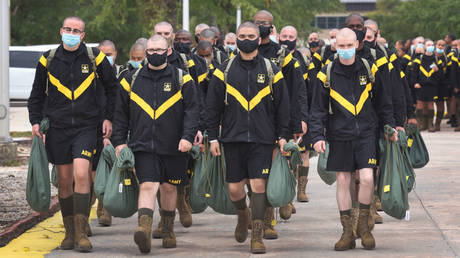
The nation’s males have reportedly lost interest in military service as they increasingly withdraw from society
American men have reportedly lost interest in military service, a trend that mirrors a broader withdrawal from society. This decline in male enlistment is driving persistent shortfalls in US Army recruiting and increasing the nation’s reliance on female troops.
Male enlistment has plummeted by 35% over the past decade, falling from around 58,000 in 2013 to 37,700 last year, according to Military.com, citing US Army recruiting data. In contrast, female enlistment has remained stable at around 10,000 recruits annually.
The dwindling number of men willing to enlist has left the Army struggling to meet its recruiting goals. The largest US military branch missed its new troop targets by approximately 10,000 enlistments last year and by 15,000 in 2022. Other branches have faced similar recruitment shortfalls. The Army has reduced its enlistment target this year by 10,000 troops, aiming for 55,000.
US Representative Matt Gaetz (R-Florida) and other conservative politicians have blamed the military’s recruiting crisis on “woke ideology,” claiming that an emphasis on criteria like race, gender and sexual orientation at the expense of combat readiness is hindering recruitment. The latest Reagan National Defense Survey, released in November, revealed that only 46% of Americans have a “great deal” of trust in their nation’s military, a significant decrease from 70% in 2018. Approximately half of the survey respondents cited “woke” practices as a reason for their declining confidence.
However, the Military.com report highlights that beyond cultural issues, experts point to broader challenges facing American men, including a “national crisis of masculinity.” Rates of suicide and drug overdoses have increased, while men are less likely to pursue higher education or build careers. In fact, the media outlet states that US men are “slowly disappearing from the general workforce.”
This trend “goes way beyond military recruitment,” according to Ronald Levant, an Ohio psychology professor and former president of the American Psychological Association. “It really has to do with social change. I think there is an amotivational syndrome that seems to permeate a lot of young men today. They’re just not motivated to do very much.”
As of last month, only 64.9% of US men held a job, a decline from a peak of over 84% in the 1950s, according to the federal Bureau of Labor Statistics. Over the same period, female participation in the labor force has nearly doubled, reaching 55.4%.
US Army demographic data indicates that the military has become less male and less white in recent years. The active-duty force was 84.4% male in 2023, down from 86.4% a decade earlier. Whites made up 53.5% of the troops last year, a decrease from 61.7% in 2011.
